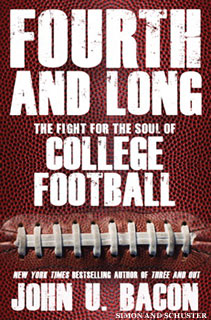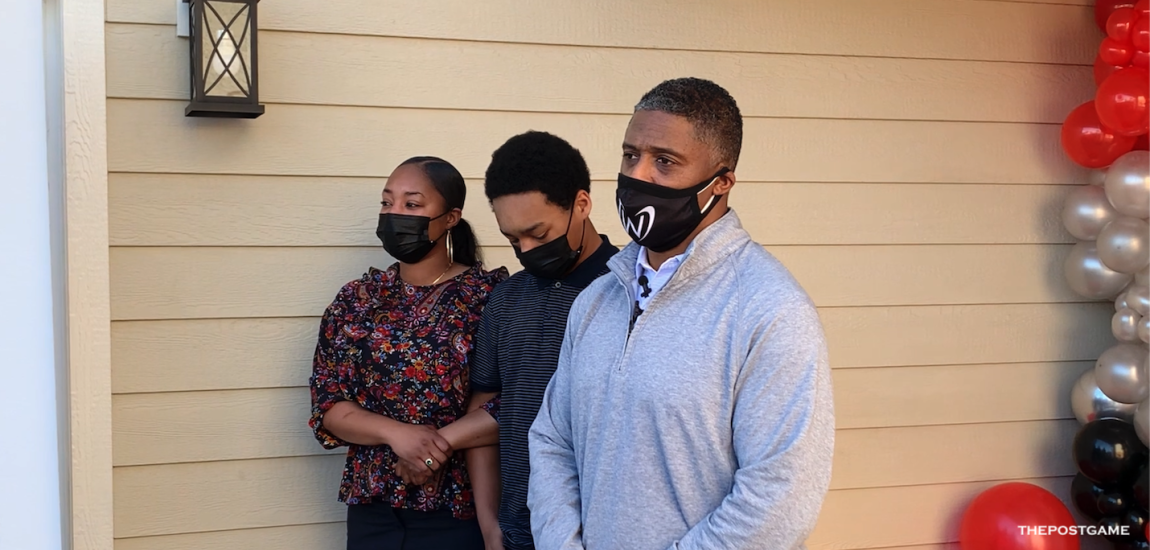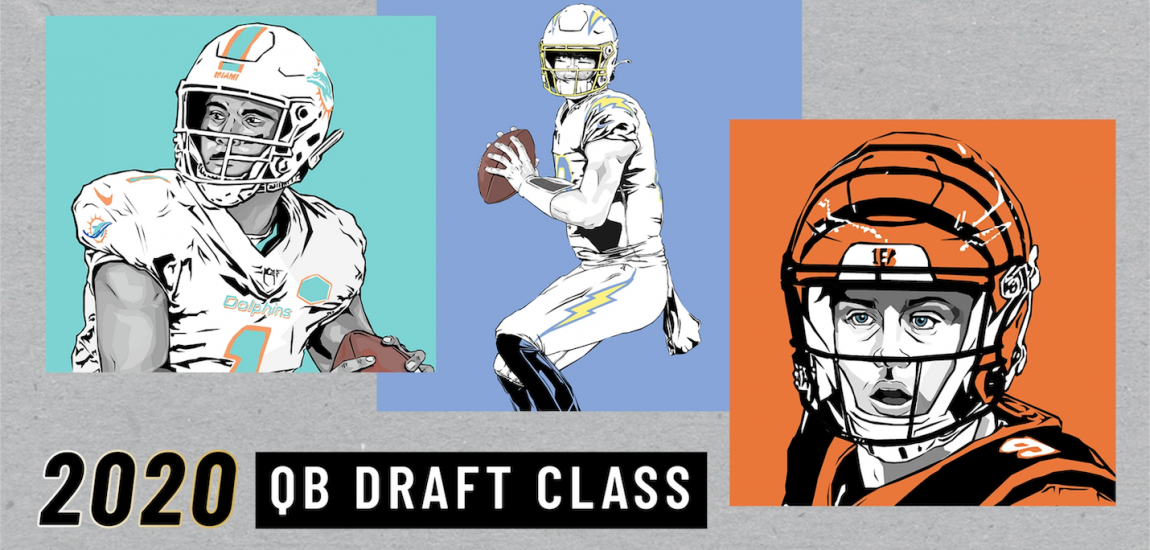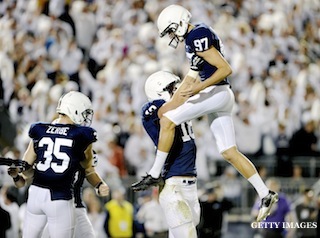
"That was the best game I've ever seen!"
OK, the speaker, Aiden Field -- the son of Bill O'Brien's high school buddy -- happened to be all of 5 years old. But after Penn State took four overtimes to beat Michigan, 43-40, many people ten times Aiden's age and older were saying the same thing.
No, it wasn't football at its finest -- a combined 7-for-34 third down conversions, 12 penalties and seven turnovers told you that -- but it was one of the season's most exciting nights.
When two teams swap the lead four times, and tie three times along the way, it's easy point to a handful of turning points on either side. But the final twist occurred in the fourth overtime, when Penn State -- down 40-37 -- faced fourth-and-one on Michigan's 16-yard line.
What O'Brien did next might just have launched Penn State's program -- so beholden to its glorious past, and held back by scandal and sanctions -- into the future, which suddenly looks pretty bright.
On July 23, 2012, Mark Emmert delivered Penn State's sanctions for the Jerry Sandusky scandal, which wiped out 14 years of Penn State's rich history, including 111 victories from 1998 to 2011, and threatened its future with penalty-free transfers and a drastic reduction in scholarships. Emmert stated Penn State's penalties might be considered "greater than any other seen in NCAA history."
Just about everyone expected the program to implode. That included the team's underclassman, one of whom told senior Pete Massaro most of them planned to leave, then concluded, "Penn State football is dead."
Massaro believed it. "I thought it was the end of Penn State football."
But O'Brien, his staff and the seniors used every resource they had that week -- from endless phone calls and meetings to ESPN appearances to inviting hundreds of lettermen to talk to the players -- just to keep the team together. They suffered a few key departures, but not many.
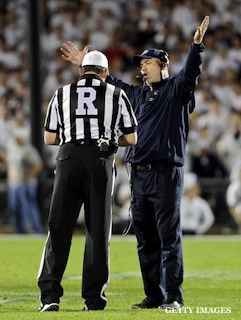
But after opening the season with losses to Ohio University and Virginia -- their worst start in a decade -- everyone outside Penn State's football building expected them to collapse again. But when I arrived in State College the Monday after the second loss, fully expecting to see cracks running through the foundation, I discovered the opposite: a team even more unified, and more determined.
They proved it by winning their next five games, and finishing with an 8-4 record, capped by an overtime win over the eventual Big Ten champion, Wisconsin.
No, Penn State couldn't go to a bowl game, but that just served to expose a dirty little secret: Unless it's a BCS bowl, most players at top programs like Penn State's would rather stay home -- just like their fans do. The NCAA might have made a grave tactical error by letting the Penn State players see how good life can be without having to schlep to Shreveport, Boise or Detroit for a meaningless game over the holidays.
Penn State showed the entire nation how much fun football still is even after the NCAA takes almost everything away. For my latest book, Fourth and Long, I was embedded inside the Penn State program, and every single one of the dozens of players, coaches and staffers I talked with told me it was their favorite season.
"For me," Larry Johnson, Sr., said, "the 2012 season was the best season I've ever had as a coach, at any level."
Since Johnson led high school teams to state titles, and served on the staff of Penn State's 2005 Big Ten champions, that's saying something. "Maybe the highlight of my life, outside the birth of my kids."
But saving the program is one thing. Restoring it is another. This fall marked a return to the reality the NCAA had left the Lions to face. Their three best defensive players were drafted, and their quarterback and running back made NFL rosters as free agents. Replacing a legendary senior class of leaders with just 14 scholarship freshmen, you get a rocky 3-2 start, capped by a 44-24 loss the week before to Indiana -- the first time in 17 contests Penn State ever dropped a game to the Hoosiers.
But if there's one thing these Penn State players can do, it's take a punch. The Monday morning after the Indiana debacle -- echoing the Monday after the heartbreaker against Virginia the year before -- the players put in one of their best workouts this season. "They were jacked up to play Michigan," strength coach Craig Fitzgerald said. "They were ready to go."

The athletic department raised the stakes by replacing the usual homecoming tomato can for the Wolverines, and calling for a full-stadium white-out.
Thanks to an over-ambitious seat license program, the Lions' six-year streak of 100,000-plus crowds ended in 2011, before Sandusky was arrested, the second of four consecutive seasons their attendance dropped. But not on Oct. 12, a day too warm to be considered "football weather." 107,884 were drawn to Beaver Stadium, including 75 top recruits, just about every candidate the coaches coveted among them. Thanks to the NCAA's decision a few weeks earlier to allow Penn State 20 scholarships for 2014, and a full 25 the next year, the coaches hoped to take full advantage Saturday night.
Of course, Penn State's "all in" strategy could have easily backfired with a public humiliation in front of a packed house and an ESPN audience. But they knew were not going to get back to the top echelon by playing it safe.
Michigan had its own problems getting past lowly Akron and UConn, but the Wolverines were still undefeated, ranked, and had a full roster of 85 scholarship players, 70 of whom traveled to Penn State. While the Wolverines are recovering from the transfers and weak recruiting class that followed Rich Rodriguez's final year in Ann Arbor, Brady Hoke and his staff are signing blue chips at levels never seen in Ann Arbor, even under Bo Schembechler. Most of their top recruits are still underclassmen, of course, but Hoke probably wouldn't swap his young recruits for the guys on the other side of the field.
Penn State had a mere 57 scholarship players in uniform that night, at home, including a dozen-plus glorified walk-ons -- O'Brien calls them "run-ons" -- who received scholarships this year simply because no one else was going to claim them. The list included their starting holder, Adam Geiger, a true freshman playing in his first game, their starting long-snapper, Zach Ladonis, who just made the team a few weeks ago in an all-campus try-out, and nine walk-ons on the kick coverage team.

On paper, the Lions had no business battling the Wolverines. But on paper, the Lions should have folded the year before -- twice. In State College, they have grown accustomed to ignoring the experts.
The Lions shot out to a 21-10 halftime lead, then helped Michigan leap ahead, 34-24, with ten minutes left. But Michigan showed no killer instinct -- from offensive coordinator Al Borges in the press box to the coaches on the sidelines to the players on the field -- and failed to put Penn State away.
Credit some of Penn State's "run-ons" for keeping the blue-chips at bay. That kick off unit, with nine walk-ons, didn't let the Wolverines get past the 35-yard line in seven returns. Penn State's defense notched a season-high 11 tackles-for-loss, and held Michigan tailback Fitzgerald Toussaint to a historically anemic 27 yards on 27 carries.
Faced with their own make-or-break play, on third-and-nine from the Penn State 27 yard line, the Wolverines couldn't even snap the ball in time. After a delay of game, they punted the ball into the end zone. That was enough for Penn State true-freshman quarterback Christian Hackenberg to run an impressive 80-yard drive in 23 seconds to tie the score, and force overtime.
Michigan blew three chances to kick walk-off field goals. The normally reliable Brendan Gibbons missed two and had another blocked.
Down 40-37 in the fourth overtime, and facing fourth-and-one on Michigan's 16, O'Brien had to make his big decision -- one which would not have been debated by the coaches across the field. If you were playing not to lose -- which seemed to be Michigan's plan -- you wouldn't even think about it. You'd kick the field goal, and live to fight another overtime.
But not Bill O'Brien. He had only a few seconds to make his decision, but a lifetime of crunch-time calls to draw on. The ones he regretted most? When they played it safe, and lost. Whatever was going to happen next, he resolved, it wasn't going to be that.
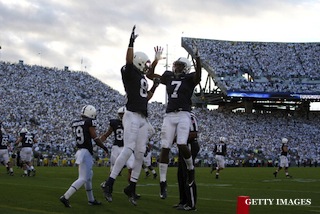
"I looked down at the field," he told me, "and the grass had been all chewed up. We'd run about 180 plays. I looked at the players, and they'd all emptied their tanks -- and we don't have as many subs as Michigan does. I figured it was time to take our chances, and win the game. If we didn't, we didn't."
He called Toga, then watched Bill Belton run through Michigan's defensive line for three yards and a first down. "I felt good about the decision -- for all of about two seconds," he said. "Then I started thinking about the next play. We didn't exactly waste a lot of time patting ourselves on the back."
After that gamble paid off, it seemed inevitable that the Lions were headed for the end zone -- and four plays later, they were, when Belton ran up the middle, bounced to the left and trotted across the goal line. Game over.
The celebration that followed is hard to describe, even days later, because it was at least one part salvation. The ancient press box shook for minutes.
Penn State's veteran equipment manager, Brad "Spider" Caldwell, said. "I was spent! I couldn't even react. I just stood there, too tired to cheer. I went into the equipment room, and ... got emotional.
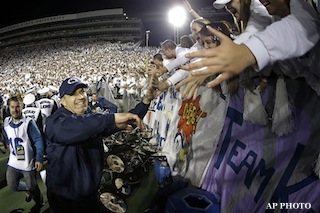
"Bill's speech afterward was one of the best I've heard. ‘You'll forever remember this game, whatever you do in life. You never quit, you never gave up.' You could tell he wanted to cry."
Others compared it the 2005 Ohio State game -- when Penn State beat the sixth-ranked Buckeyes and Heisman Trophy winner Troy Smith, 17-10, in the stadium's second white-out, on their way to a Big Ten title -- or the 1982 game against Nebraska, a 27-24 thriller en route to the school's first national title.
Those teams had more talent, but not more passion -- and that's what college football fans seem to care about most.
"I've been thinking back, thinking about all of them," said Spider Caldwell, and he goes back to 1983. "The local paper ranked it behind only Nebraska, 1982. For me, Ohio State in 2005 is the standard. But game-wise – the plays, the scenarios, the blocked field goal, the 23-second drive -- this one had way more drama, no question. The emotions!"
It looked like old times, from the packed stadium to the rowdy tailgates to the lines outside the bars.
"It was unbelievable," Penn State's recruiting coordinator, Bill Kavanagh, told me. "The recruits' experience -- the tailgating, the atmosphere, the game itself -- showed them what Penn State truly is: Thousands of people who love the school. We were given the stage to show the best players in the country what Penn State really is -- which we hadn't had too many times recently -- and obviously Penn State came up huge. We won't have another game like that, all year."
They might not need to. Having just beaten Michigan with maybe 57 scholarship players, it won't be hard for the recruits to imagine what Penn State could do with 75 next year, then 80, and 85.
Those of us who love college football -- where every game is a playoff, and you almost never get a second chance at the same opponent the same season -- tend to have the perspective of 13-year-olds. Whatever happened last week, whether it's a great victory or a devastating defeat, we're convinced is bound to happen the rest of the season.
Michigan fans were apoplectic, with some openly wondering for the first time if Hoke is the right man for Michigan. But outbursts aside, he will almost certainly get the chance to develop his great recruits, and could still fulfill the promise fans had in him from the start. But if the local talk shows and fan blogs are any indications -- MGoBlog's Ace Anbender entire analysis consisted of the following: "That was the stupidest f***ing game I've seen in my life. The end." -- it's clear Hoke's honeymoon is over. He will be judged not by the happy transition from Rodriguez, but what happens next.
After a wild, back-and-forth 63-47 victory this past weekend over Indiana that featured a staggering 1,323 yards total offense, and much less defense, Michigan stands at a very shaky 6-1, but 6-1 nonetheless. The natives are grumbling, but not booing.
O'Brien himself reminded me, "It's just one game. Just like last week -- and some people wanted our heads after Indiana. What it means to the future depends on us. We've got our most difficult opponent coming up."
When Penn State travels to Ohio State this week, the Lions will be heavy underdogs -- and rightly so. Urban Meyer is not likely to show any mercy.
All true -- but something changed Saturday night. For one glorious day, the sun came out, the fans came back, the Lions won a game for the ages – and a few dozen top recruits saw it all. If they don't come to Penn State after that, they weren't coming to Penn State anyway.
If Bill O'Brien -- who once coached Tom Brady, of course -- can turn a two-star walk-on named Matt McGloin into a back-up for the Oakland Raiders, it's scary to imagine what he might do with a purebred like Hackenberg, and the others who might follow.
After Emmert took away all their presents, Penn State still had its best Christmas ever -- literally, in their case, savoring a historic season with their families at home. But after this Saturday night, the Lions might be getting their presents back sooner than even they had dared to hope.
"One of the most satisfying things is, we're surviving this," Spider Caldwell said. "We're making it through. The naysayers who want to drive us into the ground aren't finishing the job. There's just too much good here not to overcome the evil."
That assessment might be premature -- but it didn't look that way Saturday night.
-- JOHN U. BACON is the author, most recently, of Fourth and Long: The Fight for the Soul of College Football, a New York Times bestseller. He gives weekly commentary on Michigan Radio, teaches at the University of Michigan and Northwestern's Medill School of Journalism, and speaks nationwide on leadership and diversity. Learn more at JohnUBacon.com.

